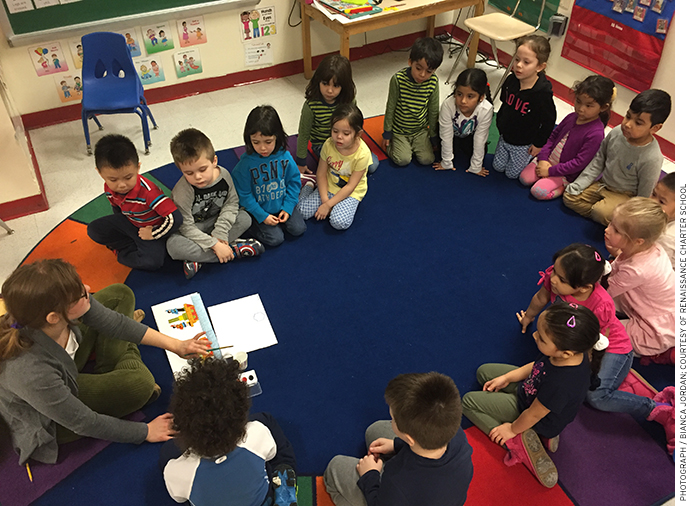
Over the past 20 years, both charter schools and pre-kindergarten education have taken on increasingly prominent roles in the schooling of America’s children. Charter schools in 43 states now serve more than 2.6 million students—roughly six percent of all students attending public schools. And more than two-thirds of four-year-olds attend some form of public or privately funded preschool, with 1.4 million of them enrolled in state-funded pre-K programs.
This growth is far from accidental. Research shows that high-quality preschool education has a lasting impact on children’s school success, and in recent years, cities and states have moved to increase access to preschool programs. At the same time, demand for good charter schools has swelled, as the best of them have notched remarkable success on measures of student achievement. Moreover, it is low-income students who have reaped the greatest benefits from the growth of these two reforms: Most state pre-K programs target children in poverty, in hopes of narrowing the achievement gap, and research shows that charters produce the strongest results for disadvantaged youth. Yet recent research also suggests that neither high-quality charter schools nor pre-K alone may sufficiently level the playing field between children in poverty and their middle-class peers over the long term.
This point raises an intriguing question: What happens if we combine high-performing charter schools with high-quality pre-K education? Could the combination of these two reforms produce a result better than the sum of its parts? This is not an abstract question. In most of the 38 states that do have both charters and pre-K, there is at least one charter school serving preschoolers. Charter schools that offer preschool programs afford us the opportunity to examine the challenges they face, the aspirations they hold, and the ways in which they are serving young children.
To date, charter pre-K programs have received little attention. In 2015, we undertook the first national study of state policies related to pre-K and charter schools. We found that nine states prohibit charter schools from serving pre-K students. Even in states where charters can offer pre-K, they often face substantial barriers to doing so. Many of these barriers reflect specific variations in individual states’ pre-K or charter policies, but several recurring themes emerge across states: Charters must compete with long-standing community-based and district providers for scarce pre-K resources. Inadequate funding for public pre-K programs makes it challenging for charters to offer high-quality pre-K programming. Public programs must also adhere to “quality” standards that impose cumbersome input or process requirements that infringe on charter autonomy.
Over the past year, to better understand how these barriers play out on the ground and how charter schools serve preschoolers, we visited charter pre-K programs in several states.
We learned that policy barriers create real challenges, even when charter schools manage to overcome them. Charter schools in California and New York face funding challenges and intrusive quality standards that limit their autonomy. In contrast, Washington, D.C., where public policies and funding offer a much more supportive climate, illustrates the potential of charter schools to bring innovation to the pre-K sector.
Despite the challenges faced in most areas of the country, some charter schools offer high-quality pre-K programs that adapt the best assets of their distinctive models and cultures to meet the unique needs of young children and prepare them well for kindergarten. Their success stories offer lessons for both policymakers interested in expanding access to quality early learning, and for charter-school educators seeking to serve preschoolers.
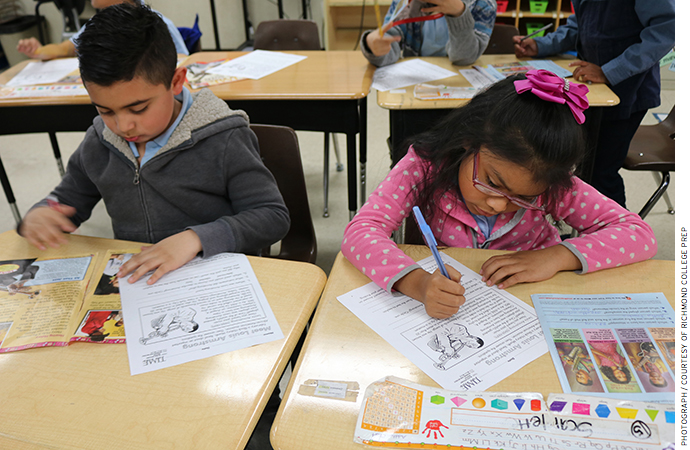
Challenges in California
Richmond College Prep sits in a gritty postindustrial urban neighborhood in Oakland known as the Iron Triangle. The community has a legacy of early childhood innovation: Richmond College Prep’s kindergarten and 1st-grade students learn and play in a building that once provided federally funded round-the-clock care to children whose mothers labored in Richmond’s shipyards during World War II. The school itself grew out of a nonprofit preschool funded with proceeds from a $180 million settlement following a Chevron Oil refinery explosion in the late 1990s. When the preschool’s founders realized there were no good elementary schools for its graduates, they applied for a charter, and Richmond College Prep elementary school opened in 2006. Ten years later, it is one of the highest-performing charter schools in the city, serving 48 preschoolers and 291 students from transitional kindergarten through 6th grade.
Down the coast in Los Angeles, Camino Nuevo Charter Academy, a high-performing charter-management organization founded in 2000, serves 3,400 students on eight campuses, including 120 preschoolers in a state-of-the-art early-childhood campus. Camino Nuevo’s CEO Ana Ponce knew that achieving the network’s goal of educational equity for students who come from the poorest communities of Los Angeles required starting children early—but many of the school’s students were entering kindergarten with no prior preschool or early learning experiences. Thus, Camino Nuevo opened its early childhood center in 2004.
In theory, charter schools in California can get financial support for their early learning services through two funding streams: the California State Preschool Program (CSPP) for low-income three- and four-year-olds, and a state fund for transitional kindergarten for all four-year-olds born between September and December who miss the cutoff date for kindergarten. By law, charter schools that serve children eligible for transitional kindergarten must offer it: in 2015, 235 charter schools automatically received funds from the state to offer the program. But securing CSPP funding is more arduous. Charter schools must apply for it, and so far only four have successfully done so. Alternatively, a charter school can try to contract with a local education agency that receives CSPP funding, but doing that is difficult. Richmond Prep and Camino Nuevo are unique among charter schools in California in that they receive funding from both programs.
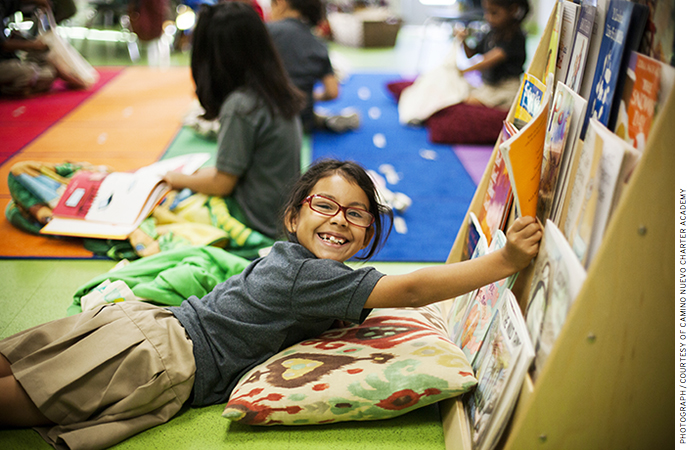
Both Camino Nuevo and Richmond College Prep are high-performing schools that don’t fit the stereotype of a “no excuses” charter school. Richmond emphasizes a nurturing, student-centered atmosphere; eschews strict disciplinary policies; and offers enrichment activities such as Mexican folk dancing, “mindful life,” and gospel choir. Camino Nuevo offers a bilingual English-Spanish program and a rich curriculum emphasizing the arts. These values also infuse the schools’ preschool programs.
Both schools have also dedicated effort to designing developmentally appropriate pre-K programs. Richmond Prep’s CEO Peppina Liano, a longtime Montessori educator, designed the preschool as a Montessori program. The Montessori model fosters children’s independence and emphasizes self-directed, hands-on learning, with highly trained teachers serving as “guides.” Montessori is implemented in thousands of schools internationally, including more than 450 public schools in the United States. Alicia Garcia, associate director of the Camino Nuevo Early Childhood Education Center, has a Head Start background that informs the preschool’s whole-child approach. Camino Nuevo’s preschool uses the evidence-based Tools of the Mind curriculum, which emphasizes development of executive function skills while also supporting children’s vocabulary, language, and social-emotional development. The school’s fifty-fifty bilingual approach, in which children and teachers alternate days using English and Spanish, aligns well with Tools of the Mind and prepares preschoolers for Camino Nuevo’s bilingual elementary school as well as for other elementary schools that provide instruction in English only.
Both preschool programs face hurdles, however. “Public funding is the biggest challenge,” says Camino Nuevo’s Ponce. Before they began receiving public funds, both schools’ preschool programs operated with private funding alone. But the current state funding—less than half of what charters receive for K–12 students—isn’t enough to cover the costs of a high-quality pre-K program. Richmond College Prep receives only 20 dollars a day for each pre-K student; to fill the gap, CEO Liano must raise significant funding each year from individual and foundation donors. Camino Nuevo has been fortunate to receive supplemental funds from the Los Angeles Universal Preschool (LAUP) program, which allows the school to enhance program quality. Even with these additional funds, however, Camino Nuevo struggles to retain high-quality staff, given the salary levels its restricted resources dictate. A recent decision by the Los Angeles First Five Commission (known as First 5 LA) to eliminate funding for preschool slots through LAUP means that Camino Nuevo will no longer receive supplemental LAUP funds—and will need to raise $150,000 annually to maintain its current preschool enrollment and level of quality.
Moving preschool students into kindergarten at the same school is another challenge. Because pre-K funding in California comes from a different funding stream than that of K–12, the state bureaucracy does not consider pre-K a part of the charter school, but a separate program. As a result, pre-K students cannot matriculate directly into kindergarten but must go through a lottery to enroll. This administrative issue can create very real logistical challenges for charter schools, parents, and students, such as difficulties with recruitment and children’s academic stability. Charters can offer a lottery preference to their pre-K students but must give higher priority to children with siblings enrolled in other grades of the school—whether or not they attended pre-K there. As a result, only about half of Camino Nuevo’s preschoolers are able to enroll in its kindergarten. Richmond Prep’s kindergarten does not have enough space to serve all children completing its preschool and transitional kindergarten programs, but staff report that most children who want to enroll are able to do so, because high mobility in the surrounding community leads to some natural attrition between grades each year.
Despite their challenges, both schools believe that pre-K is critical to their mission and are committed to continuing to offer it. “As we learn more about the brain and early development,” says Ponce, “it’s essential that we provide this.”
Universal Pre-K in New York
In 2014, New York City embarked on an ambitious effort to make full-day pre-K available to all four-year-olds in the city. In just two years, the number of children enrolled in New York City pre-K programs more than tripled—from 20,000 in 2013–14 to nearly 70,000 in the 2015–16 school year. The state legislation that funded New York’s pre-K expansion also opened the door for charter schools to operate pre-K programs. Previously, they had been barred from serving preschoolers.
The Renaissance Charter School, a high-performing school in Queens that had been serving grades K–12, was one of the first to seize the new opportunity. The school’s leaders had long wanted to offer pre-K, and had considered doing so through a separate nonprofit, as other New York charters did prior to 2014. But they rejected that approach because they wanted their pre-K students to be able to enroll directly in their kindergarten without going through another lottery. When the legislature allowed charters to offer pre-K, Renaissance moved quickly, opening a preschool program in the 2014–15 school year. To launch the pre-K program, Renaissance hired Nicole De Nino, an experienced pre-K and elementary teacher, and gave her authority to select curriculum, materials, and furnishings. Rather than adopting a specific pre-K model or philosophy, the school has taken an “eclectic” approach that draws on a variety of early childhood philosophies. Creative Curriculum, which is widely used in pre-K education, is the primary curriculum, supplemented by Handwriting Without Tears and Mathematics in the City. “We wanted to get children ready for kindergarten,” explains De Nino, “but we wanted to balance that with play and make sure that everything we do with children is developmentally appropriate.”
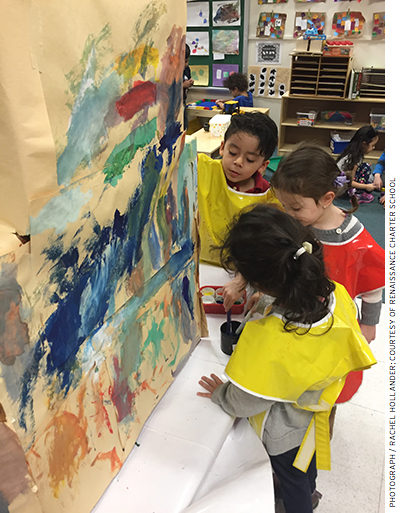
This philosophy aligns with Renaissance’s broader K–12 approach, which offers integrated, progressive education that incorporates a strong focus on music and the arts. Renaissance uses a “looping” model, in which most teachers remain with students for two years across all grades, including high school, so pre-K teachers generally follow their students into kindergarten. This practice helps teachers build strong relationships with students and families, and supports alignment between pre-K and the early elementary grades.
Renaissance has seen clear benefits to having pre-K in the school. Starting children early allows the school to build stronger relationships with families, and attending school with older siblings helps smooth preschoolers’ transitions to school. Being located in the Renaissance facility also enables pre-K children to benefit from “specials” that the school offers, including Spanish, dance, yoga, and gym.
Because the New York City Department of Education administers the citywide pre-K program, Renaissance is subject to the DOE’s pre-K standards and monitoring, even though it is a charter school. And although the school has a positive relationship with the Department of Education, these requirements at times overstep the lines of charter autonomy.
In general, charter schools are held accountable for results, and in return they are given greater autonomy than district schools. New York’s pre-K program, in contrast, holds pre-K providers accountable for a checklist of input requirements. Some of these requirements are necessary and reasonable to protect child health and safety, or ensure that programs have a sound curriculum and strategies for assessing children’s learning. Others, however, are prescriptive, burdensome, and not clearly linked to program quality. In New York, the state sends in program monitors to assess if a pre-K classroom has a “block building area with an adequate supply of blocks in varied sizes that is organized and labeled,” “a private space for each child’s possessions,” and a posted daily schedule that is “referenced daily, represented in pictures and words, and displayed at children’s eye level.”
This tension between charter autonomy and public pre-K standards is not unique to New York City; it occurs in many states. The founders of the charter movement envisaged that increased autonomy would remove the ceiling for high achievers. Unfortunately, pre-K standards are often designed to ensure that providers meet a minimum floor of quality, not to encourage them to pursue ever-higher levels of excellence. Moreover, because in most states a charter pre-K program is not considered an official part of the larger school but a separate program, the autonomies granted to charters often do not extend to their preschool classrooms.
Government requirements can sometimes discourage charter schools from offering pre-K. Success Academy, a high-performing New York City charter network, recently canceled its pre-K program after a long, public battle with the city’s DOE over pre-K autonomy. The department wouldn’t give Success Academy any pre-K funding until the network agreed to the city’s monitoring requirements, but Success Academy refused, claiming the DOE had no authority to oversee the network’s pre-K program. Although New York’s Pre-K for All legislation gives the authority to monitor pre-K programs to charter school authorizers, it also sets quality standards and monitoring requirements that differ from authorizers’ typical practices. The New York State Education Department eventually ruled in favor of the city, though Success Academy plans to appeal the state’s decision.
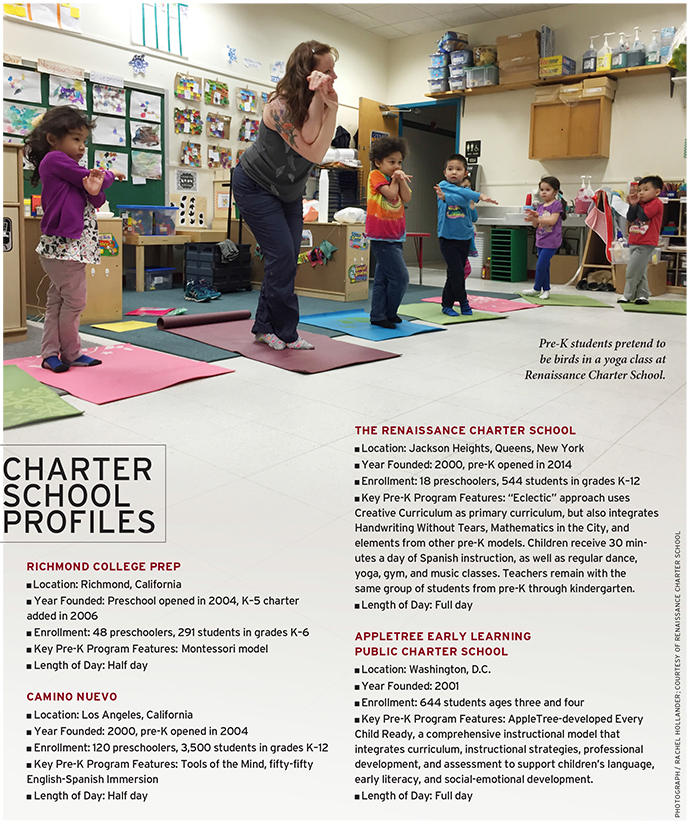
Pre-K Innovation in D.C.
If California and New York illustrate the challenges charter schools face in offering pre-K in many states, Washington, D.C., illustrates the possibilities. Unlike in most states, charter schools in the District of Columbia can enroll both three- and four-year-olds and receive roughly the same per-pupil funding for preschoolers as for K–12 students. As a result, nearly every charter elementary school in D.C. offers pre-K, serving an aggregate total of more than 12,000 preschoolers.
These charters are accountable to the District of Columbia Public Charter School Board (PCSB) for the quality and results of their pre-K programs—just as they are for grades K–12—but they are not subject to the kind of extensive, input-based quality requirements found in other pre-K programs. Instead, PCSB holds charter pre-K programs accountable for overall school quality and outcomes through an integrated Performance Management Framework for P–8 charter schools. The framework provides a holistic assessment of school performance based on student growth and achievement in grades 3–8; school climate measures, including attendance and re-enrollment; and preschool classroom quality. This approach reflects PCSB’s view that quality pre-K programs should ultimately lead to strong K–12 outcomes, while also ensuring attention to the quality of schools’ pre-K classrooms. To measure that quality, PCSB uses the Classroom Assessment Scoring System, or CLASS, an observational tool developed by researchers that focuses on the quality of adult–child interactions and has been shown to correlate with children’s learning in preschool. Charter schools are still required to set goals for and assess preschoolers’ learning, and PCSB publishes data from those assessments in annual school accountability reports, but it does not use child assessments in pre-K to grade or rank schools.
The combination of adequate funding and results-focused autonomy has fostered innovation. Briya Public Charter School, for example, offers a unique two-generation approach that combines pre-K with adult education programs for parents and early childhood educators. AppleTree Early Learning Public Charter School, a pre-K–only charter school that serves more than 800 students on eight campuses, has used its flexibility—as well as a federal Investing in Innovation grant—to develop an integrated model that combines evidence-based curriculum, early childhood assessments, and aligned professional development to help teachers deliver effective instruction focused on improving children’s language and social-emotional skills. An independent evaluation in 2014 found that AppleTree students make significant learning gains, and that the program is closing the achievement gap for high-need students upon entrance to kindergarten. Now AppleTree is working to help more pre-K programs—in both charter and other settings—replicate those results.
The thriving charter pre-K programs in D.C. demonstrate that the charter pre-K model offers an opportunity for states to better serve their neediest students, particularly because, in general, charter schools serve more disadvantaged populations. Charter schools contribute to the supply of pre-K seats in D.C.—something that New York City struggled with in its rollout of universal pre-K. Early childhood education has historically been delivered by a variety of different providers, including public and private schools, community-based childcare, and Head Start. As states continue to expand their pre-K programs, the charter model can offer another attractive option for parents in an emerging publicly funded early-childhood system, not only expanding choice and access but in many cases improving quality. Marrying pre-K with high-quality charter schools also increases the chances that children will receive a solid elementary education that sustains and builds on preschool learning gains. Some of the strongest research in education shows that high-quality charter schools and preschool, separately, foster student achievement. By combining the two, states can use the charter pre-K model to improve outcomes for the neediest students.
Ashley LiBetti Mitchel is a senior analyst at Bellwether Education Partners, a nonprofit working to help education institutions become more effective. Sara Mead is a partner at that organization.
This article appeared in the Winter 2017 issue of Education Next. Suggested citation format:
Libetti Mitchel, A., and Mead, S. (2017). The Charter Model Goes to Preschool: Despite obstacles, innovative new programs expand access. Education Next, 17(1), 36-43.


